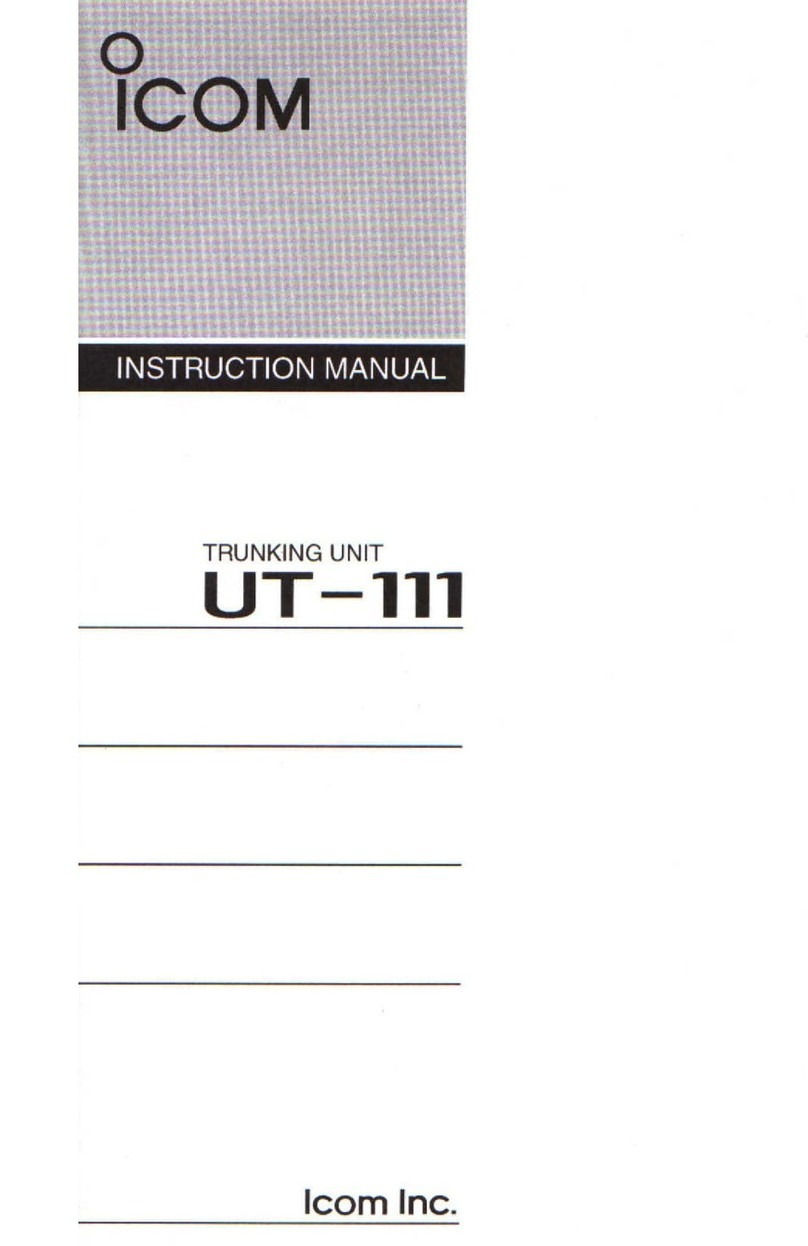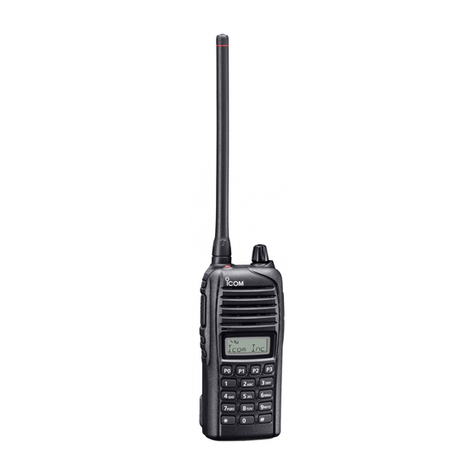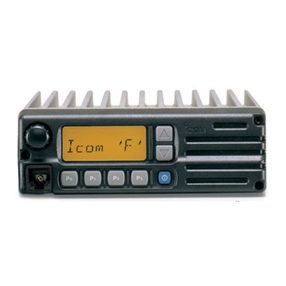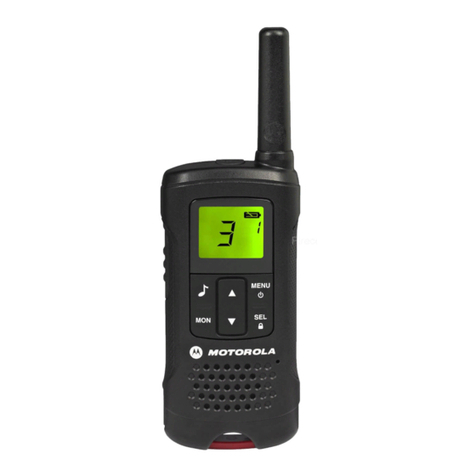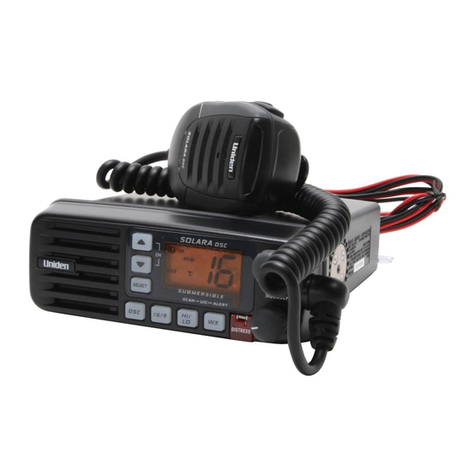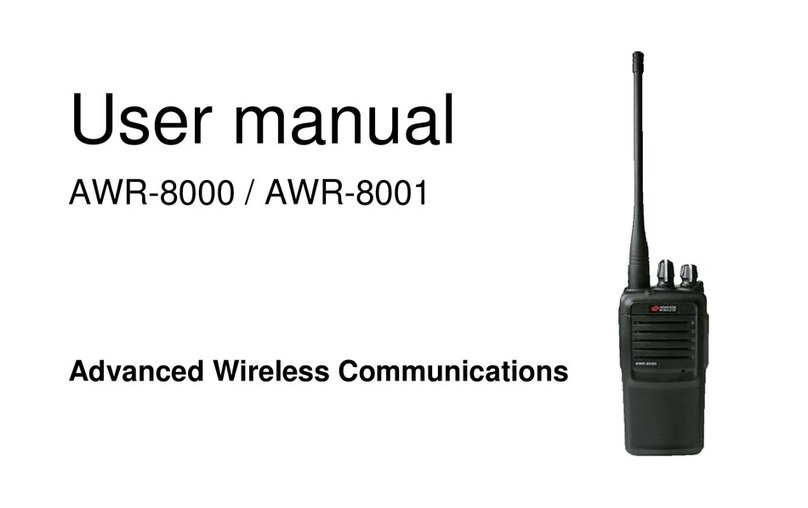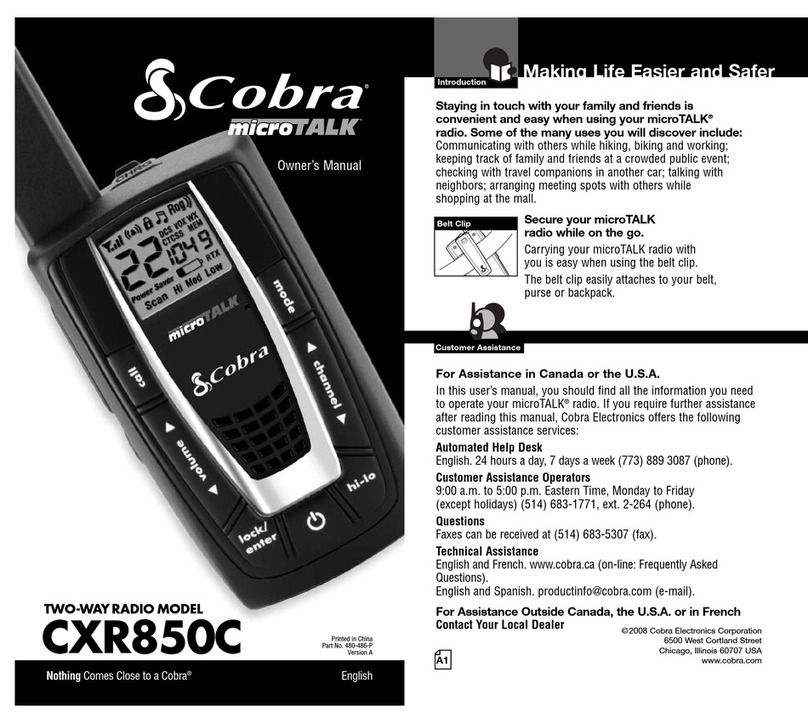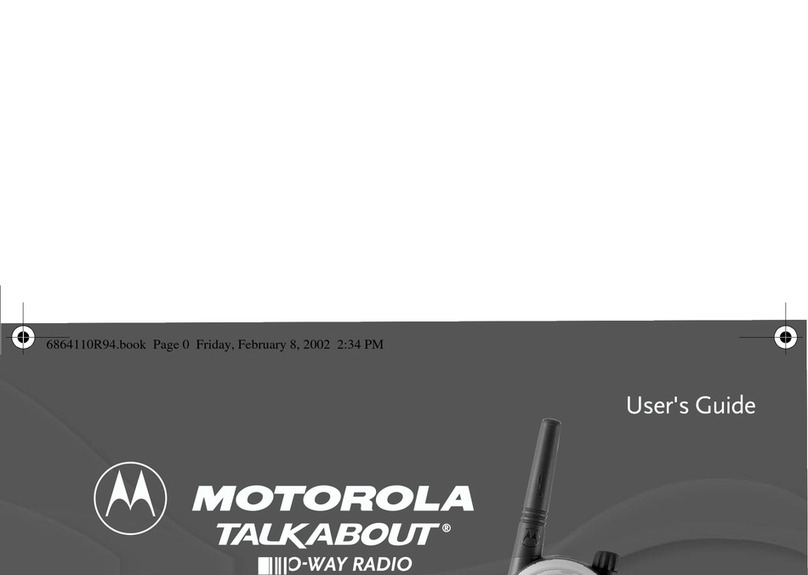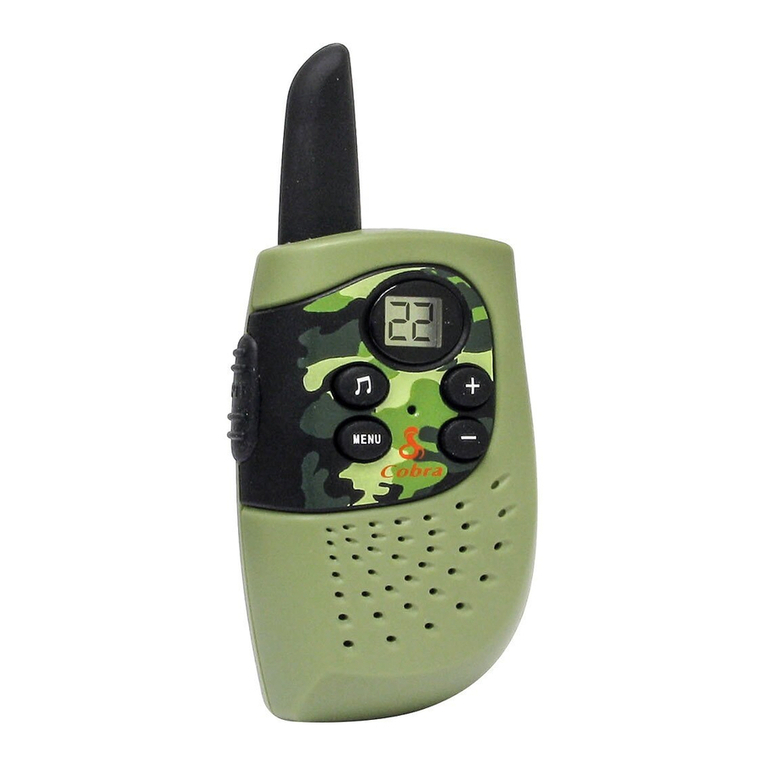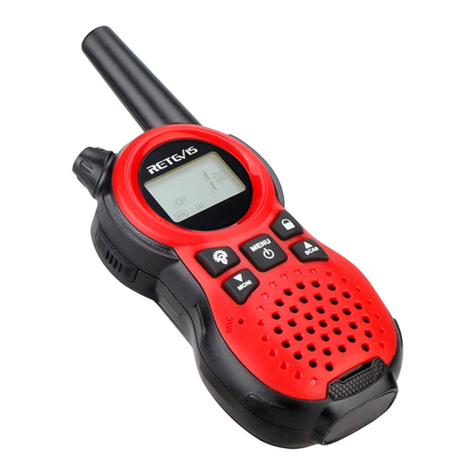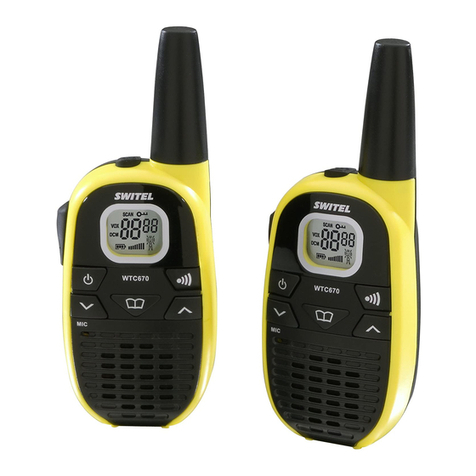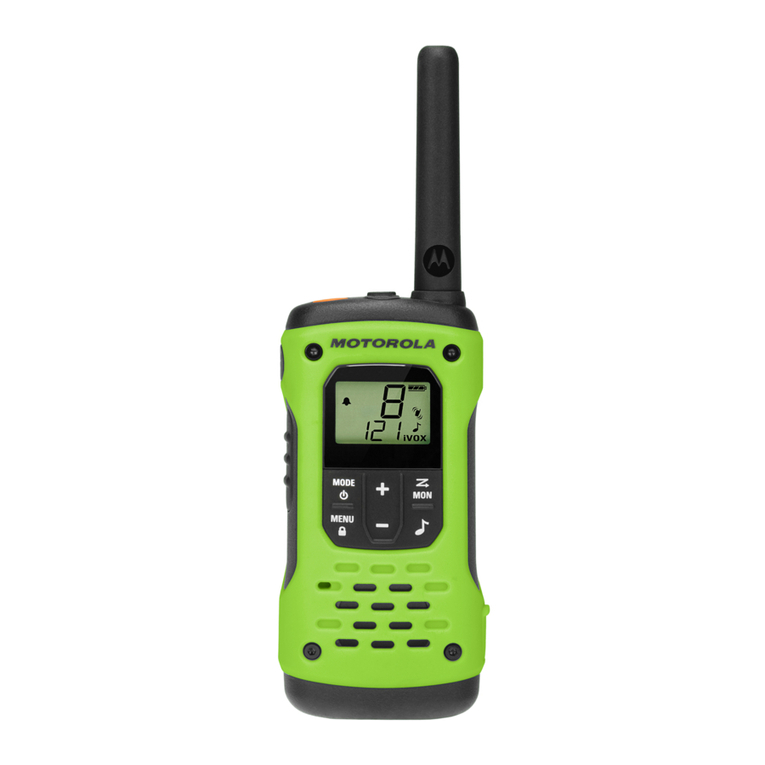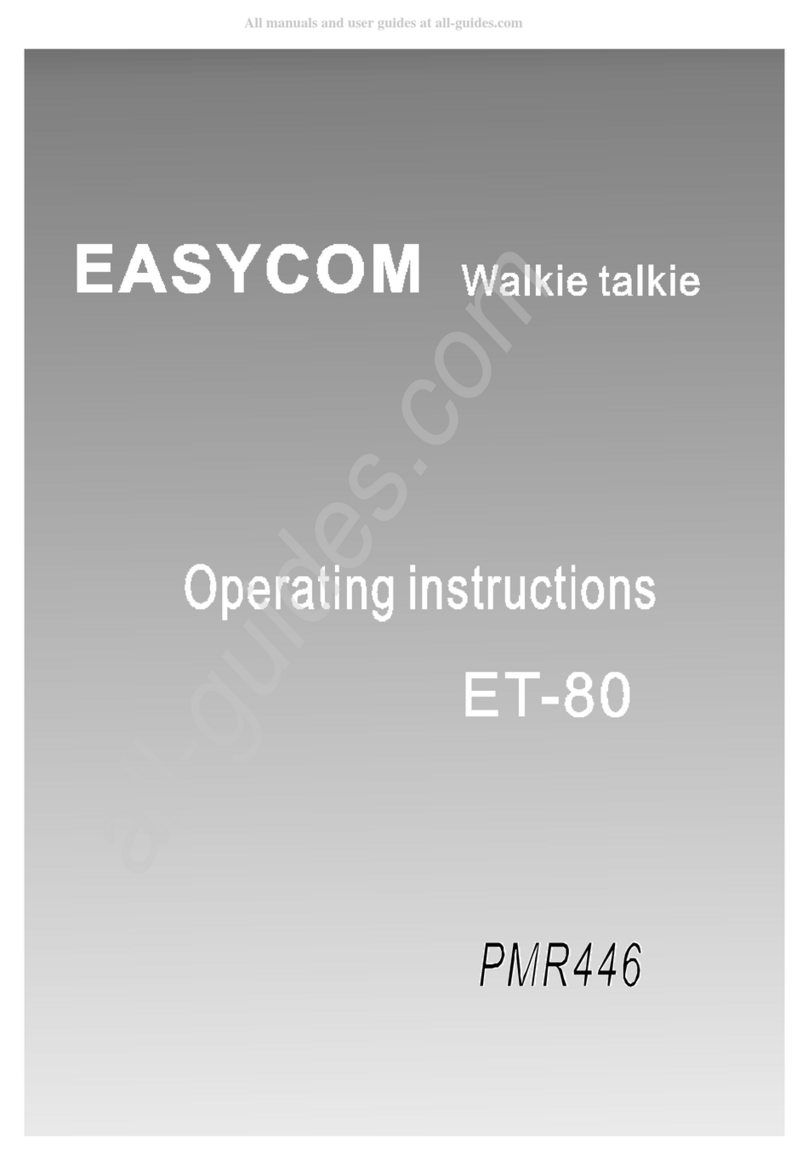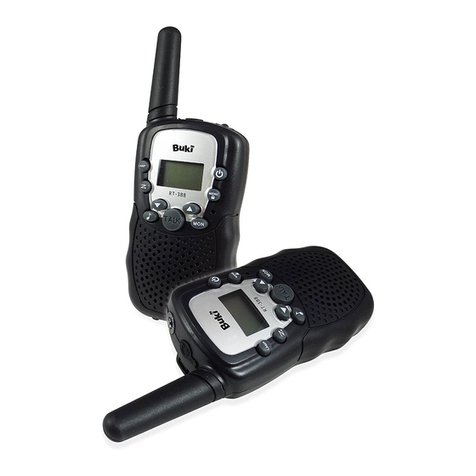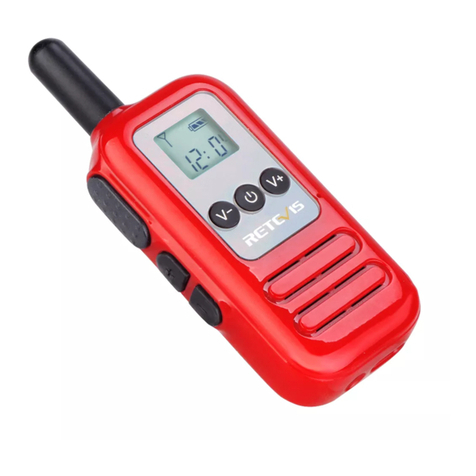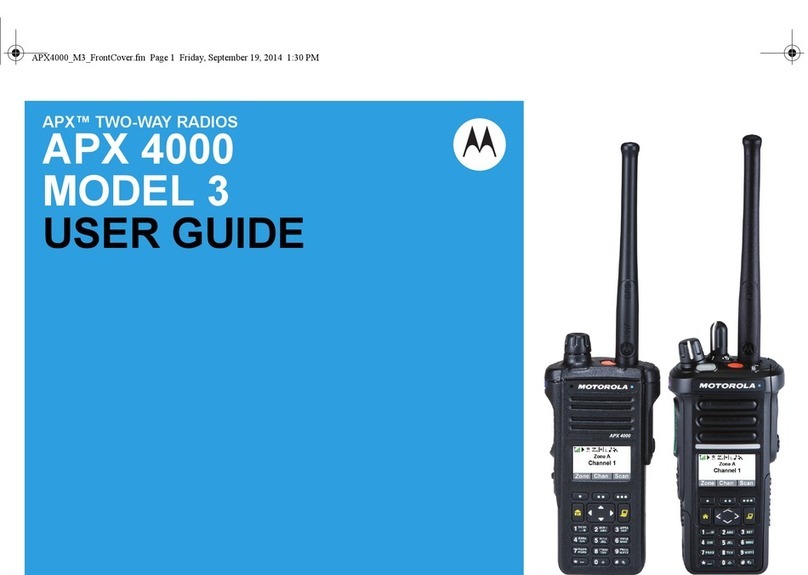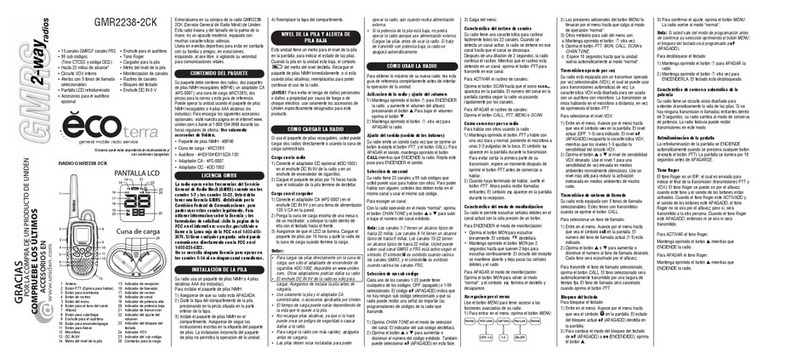Icom IC-GM1600 User manual

INSTRUCTION MANUAL
iGM1600
SURVIVAL CRAFT 2-WAY RADIO
This device complies with Part 15 of the FCC Rules. Operation is
subject to the condition that this device does not cause harmful inter-
ference.

i
SAFETY TRAINING INFORMATION
Your Icom radio generates RF electromagnetic energy during
transmit mode.
This radio has been evaluated for compliance at the distance
of 2.5 cm with the FCC RF exposure limits for “Occupational
Use Only”. In addition, your Icom radio complies with the fol-
lowing Standards and Guidelines with regard to RF energy
and electromagnetic energy levels and evaluation of such lev-
els for exposure to humans:
• FCC OET Bulletin 65 Edition 97-01 Supplement C, Evaluating Compliance
with FCC Guidelines for Human Exposure to Radio Frequency Electro-
magnetic Fields.
•American National Standards Institute (C95.1-1992), IEEE Standard for
Safety Levels with Respect to Human Exposure to Radio Frequency Elec-
tromagnetic Fields, 3 kHz to 300 GHz.
• American National Standards Institute (C95.3-1992), IEEE Recommended
Practice for the Measurement of Potentially Hazardous Electromagnetic
Fields– RF and Microwave.
• The following accessories are authorized for use with this product. Use of
accessories other than those specified may result in RF exposure levels
exceeding the FCC requirements for wireless RF exposure.; Belt Clip
(MB-86, MB-103Y), Rechargeable Ni-Cd Battery Pack (BP-224) and
Lithium Battery Pack (BP-234).
To ensure that your expose to RF electromagnetic en-
ergy is within the FCC allowable limits for occupational
use, always adhere to the following guidelines:
CAUTION
WARNING
• DO NOT operate the radio without a proper antenna attached, as this may
damage the radio and may exceed FCC RF exposure limits. A proper an-
tenna is the antenna supplied with this radio by the manufacturer or an an-
tenna specifically authorized by the manufacturer for use with this radio.
• DO NOT transmit for more than 50% of total radio use time (“50% duty
cycle”). Transmitting more than 50% of the time can cause FCC RF expo-
sure compliance requirements to be exceeded. The radio is transmitting
when the “TX indicator” light is red. You can cause the radio to transmit by
pressing the “PTT” switch or VOX function.
• ALWAYS keep the antenna at least 2.5 cm (1 inch) away from the body
when transmitting and only use the Icom belt-clips which are listed on
page 26 when attaching the radio to your belt, etc., to ensure FCC RF ex-
posure compliance requirements are not exceeded.To provide the recipi-
ents of your transmission the best sound quality, hold the radio in an
almost vertical position at least 5 cm (2 inches) from your mouth, the mi-
crophone is located next to the speaker, so you should “talk into the
speaker”.
The information listed above provides the user with the information needed to
make him or her aware of RF exposure, and what to do to assure that this radio
operates within FCC RF exposure limits.
Electromagnetic Interference/Compatibility
During transmissions, your Icom radio generates RF energy that can possibly
cause interference with other devices or systems. To avoid such interference,
turn off the radio in areas where signs are posted to do so. DO NOT operate
the transmitter in areas that are sensitive to electromagnetic radiation such as
hospitals, aircraft, and blasting sites.

ii
RECOMMENDATION
CLEAN THE TRANSCEIVER THOROUGHLY WITH FRESH
WATER after exposure to saltwater, and dry it before opera-
tion. Otherwise, the transceiver’s keys, switches and con-
trollers may become inoperable due to salt crystallization.
NOTE: DO NOT remove the battery pack when cleaning the
transceiver thoroughly with fresh water. Water may enter into
the transceiver, and damage it.
WORD DEFINITION
RWARNING
CAUTION
NOTE
Personal injury, fire hazard or electric shock
may occur.
If disregarded, inconvenience only. No risk
of personal injury, fire or electric shock.
Equipment damage may occur.
FOREWORD
Thank you for purchasing this Icom radio. The IC-GM1600 SUR-
VIVAL CRAFT 2-WAY RADIO is designed and built with Icom’s
state of the art technology and craftsmanship. With proper care,
this product should provide you with years of trouble-free oper-
ation.
IMPORTANT
READ ALL INSTRUCTIONS carefully and com-
pletely before using the transceiver.
SAVE THIS INSTRUCTION MANUAL—This in-
struction manual contains important operating instructions for
the IC-GM1600.
EXPLICIT DEFINITIONS
MIC
/SP

iii
PRECAUTION
RWARNING! NEVER connect the transceiver to an
AC outlet. This may pose a fire hazard or result in an electric
shock.
RWARNING! NEVER hold the transceiver so that the
antenna is closer than 2.5 cm (1 inch) from exposed parts of
the body, especially the face or eyes, while transmitting. The
transceiver will perform best if the microphone is 5 to 10 cm
(2 to 4 inches) away from the lips and the transceiver is verti-
cal.
NEVER connect the transceiver to a power source other
than the BP-224 or BP-234. Such a connection will ruin the
transceiver.
AVOID using or placing the transceiver in direct sunlight or
in areas with temperatures below –20°C (–4°F) or above
+60°C (+140°F) for U.S.A. version;.–20°C (–4°F) or above
+55°C (+131°F) for General version
KEEP the transceiver out of the reach of children.
KEEP the transceiver at least 0.9 meters (3.0 ft) away from
your vessel’s magnetic navigation compass.
MAKE SURE the flexible antenna and battery pack are
securely attached to the transceiver, and that the antenna and
battery pack are dry before attachment. Exposing the inside
of the transceiver to water will result in serious damage to the
transceiver.
For U.S.A. only
CAUTION: Changes or modifications to this device, not
expressly approved by Icom Inc., could void your authority to
operate this device under FCC regulations.
Icom, Icom Inc. and the logo are registered trademarks of Icom Incor-
porated (Japan) in the United States, the United Kingdom, Germany, France,
Spain, Russia and/or other countries.

iv
SAFETY TRAINING INFORMATION ............................................... i
RECOMMENDATION ...................................................................... ii
FOREWORD ................................................................................... ii
IMPORTANT .................................................................................... ii
EXPLICIT DEFINITIONS ................................................................. ii
PRECAUTION ................................................................................ iii
TABLE OF CONTENTS .................................................................. iv
1 OPERATING RULES ................................................................. 1
2 SUPPLIED ACCESSORIES AND ATTACHMENTS ............... 2–3
■Supplied accessories............................................................... 2
■Attachments............................................................................. 2
3 PANEL DESCRIPTION .......................................................... 4–6
■Front, top and side panels ....................................................... 4
■Function display ...................................................................... 5
4 BASIC OPERATION ............................................................ 7–10
■Channel selection ................................................................... 7
■Receiving and transmitting ...................................................... 8
■Call channel programming ...................................................... 9
■Adjusting the squelch level ..................................................... 9
■Lock function ......................................................................... 10
■Signal strength indicator function .......................................... 10
■Monitor function .................................................................... 10
■Backlighting function ............................................................. 10
■VOX function (FOR ON-BOARD USE ONLY) ...................... 10
5 SET MODE ......................................................................... 11–15
■SET mode programming ....................................................... 11
■SET mode items ................................................................... 12
6 BP-234 BATTERY PACK ......................................................... 16
7 BATTERY CHARGING (FOR ON-BOARD USE ONLY) .... 17–20
■Battery charging .................................................................... 17
■Battery cautions .................................................................... 17
■Optional battery chargers ...................................................... 19
8 OPTIONAL SWIVEL BELT CLIP ............................................. 21
■MB-86 contents ..................................................................... 21
■Attachment ............................................................................ 21
■Detachment ........................................................................... 21
9 OPTIONAL SPEAKER-MICROPHONE
(FOR ON-BOARD USE ONLY) ................................................ 22
■HM-125 descriptions ............................................................. 22
■Attachment ............................................................................ 22
10 CHANNEL LIST FOR SURVIVAL OPERATION....................... 23
11 TROUBLESHOOTING ............................................................. 24
12 SPECIFICATIONS .................................................................... 25
13 OPTIONS ................................................................................. 26
TABLE OF CONTENTS 1
2
3
4
5
6
7
8
9
10
11
12
13

1
OPERATING RULES
1
DPriorities
• Read all rules and regulations pertaining to priorities and
keep an up-to-date copy handy. Safety and distress calls
take priority over all others.
• You must monitor Channel 16 when you are not operating
on another channel.
• False or fraudulent distress calls are prohibited under law.
DPrivacy
• Information overheard but not intended for you cannot law-
fully be used in any way.
• Indecent or profane language is prohibited.
DRadio licenses
(1) SHIP STATION LICENSE
When your craft is equipped with a VHF FM transceiver, you
must have a current radio station license before using the
transceiver. It is unlawful to operate a ship station which is not
licensed.
Inquire through your dealer or the appropriate government
agency for a Ship-Radiotelephone license. This license in-
cludes the call sign which is your craft’s identification for radio
purposes.
(2) OPERATOR’S LICENSE
A restricted Radiotelephone Operator Permit is the license
most often held by small vessel radio operators when a radio
is not required for safety purposes.
The Restricted Radiotelephone Operator Permit must be
posted near the transceiver or be kept with the operator. Only
a licensed radio operator may operate a transceiver.
However, non-licensed individuals may talk over a transceiver
if a licensed operator starts, supervises, ends the call and
makes the necessary log entries.
A current copy of the applicable government rules and regu-
lations is only required to be on hand for vessels in which a
radio telephone is compulsory. However, even if you are not
required to have these on hand it is your responsibility to be
thoroughly acquainted with all pertinent rules and regulations.

2
2
SUPPLIED ACCESSORIES AND ATTACHMENTS
1
2
■Supplied accessories
The following accessories are supplied: Qty.
qHandstrap . . . . . . . . . . . . . . . . . . . . . . . . . . . . . . . . . . . . 1
wBattery charger (BC-158) . . . . . . . . . . . . . . . . . . . . . . . . 1
eBelt clip (MB-103Y) . . . . . . . . . . . . . . . . . . . . . . . . . . . . 1
rAC adapter (BC-147A/E)* . . . . . . . . . . . . . . . . . . . . . . . 1
tNi-Cd battery pack (BP-224) . . . . . . . . . . . . . . . . . . . . . 1
*Depends on versions.
■Attachments
DHandstrap
Pass the handstrap through the
loop on the top of the transceiver
as illustrated at right. Facilitates
carrying.
DBelt clip
Attach the belt clip to the transceiver as illustrated below.
Supplied screws
CHG
qw e
rt

3
2SUPPLIED ACCESSORIES AND ATTACHMENTS
ïBattery pack
To remove the battery pack:
Turn the screw counterclockwise, then pull the battery pack
in the direction of the arrow as shown below.
To attach the battery pack:
Insert the battery pack in the IC-GM1600 completely, then
turn the screw clockwise.
NEVER remove or insert the battery pack when the trans-
ceiver is wet or soiled. This may result water or dust get-
ting into the transceiver/battery pack and may result in the
transceiver being damaged.
NOTE: When removing or attaching the battery pack, use
a coin or flat-blade screwdriver to loosen or tighten the bot-
tom screw.
CAUTION!:
When attaching or removing a battery pack, make sure the
rubber seal is set in the groove of the battery pack cor-
rectly. If the seal is not neatly in the groove it may be dam-
aged when attaching the battery pack.
If the seal is damaged, waterproofing is not guaranteed.
OPEN
LOCK
Screw position
when removing battery
Screw position
when attaching battery
OPEN
LOCK
Make sure both the rubber seal (purple) is set into the groove
correctly and dust or else does not adhere to it.
Battery pack Battery pack
Rubber seal
Groove
Correct position Incorrect position
NOTE:
When attaching a battery pack, make sure dust or else does
not adhere to the rubber seal. If dust or anything else is on
the seal when attaching a battery pack, the water resistant
seal may be compromised.
NOTE: When the lock screw does not easily turn (feels
tight), check to ensure the battery pack is sufficiently in-
serted to the transceiver. DO NOT bang or cause high im-
pact to the battery pack, as this may damage the battery
pack/or the transceiver.

4
3
PANEL DESCRIPTION
2
3
■Front, top and side panels
qVOLUME CONTROL [VOL]
Turns power ON and adjusts the audio level.
wMICROPHONE CONNECTOR [MIC/SP]
Connects the optional external microphone.
NOTE: Attach the [MIC/SP] cap when the optional
speaker-microphone is not used.
eANTENNA
Fixed type.
rTRANSMIT/RECEIVE INDICATOR
Lights green while receiving a signal or when the squelch
is open; lights red while transmitting (lights orange while
VOX function is used).
tCALL CHANNEL KEY [CALL]
➥Selects the call channel when pushed. (p. 7)
•Channel 9* is factory default.
*Channel 16 is set as factory default by version.
➥Push for 3 sec. to enter call channel programming con-
dition. (p. 9)
yCHANNEL KEY [CH]
Push to return the previous condition when distress chan-
nel or call channel is selected. (p. 7)
uTRANSMIT POWER/LOCK KEY [Hi/Lo•]
➥Selects high or low power when pushed. (p. 8)
➥Toggles the lock function ON/OFF when pushed for
1 sec. (p. 10)
MIC
/SP
o
q
!1
!0
i
y
t
u
e
r
w

5
3PANEL DESCRIPTION
iCHANNEL 16 KEY [16]
Selects Channel 16 when pushed. (p. 7)
oCHANNEL UP/DOWN KEYS [YY]/[ZZ]
➥Selects an operating channel. (pgs. 7–8)
➥Selects the SET mode condition of the item. (p. 11)
➥Selects the SET mode item when pushed with [SQL].
(p. 11)
!0 SQUELCH SWITCH [SQL•MONI]
➥Push this switch, then adjust the squelch level with
[YY]/[ZZ]. (p. 9)
➥Manually opens the squelch for monitoring the channel
while pushed and held. (p. 10)
➥While pushing this switch, turn power ON to enter the
SET mode. (p. 11)
!1 PTT SWITCH [PTT]
Push and hold to transmit; release to receive.
■Function display
qSIGNAL STRENGTH INDICATOR (pgs. 10, 14)
Shows the relative signal strength while receiving signals.
wTRANSMIT POWER INDICATOR (p. 8)
➥“LOW”appears when low power is selected.
➥No indication appears when high power is selected.
eSQUELCH LEVEL INDICATOR (p. 9)
Shows the squelch level.
rMONITOR INDICATOR (p. 10)
Appears when the monitor function is activated.
qw r te
u
y
i
o
!0

6
3
PANEL DESCRIPTION
3
tBATTERY INDICATOR
Indicates remaining battery power.
yVOX INDICATOR
“VOX”appears when the VOX function is used. (p. 10)
uSET MODE ITEM READOUT
Indicates the SET mode items while in the SET mode.
(p. 11)
iLOCK INDICATOR
Appears when the lock function is activated. (p. 10)
oCHANNEL NUMBER READOUT
➥Indicates the selected operating channel number.
➥In SET mode, indicates the selected condition.
!0 CALL CHANNEL INDICATOR
Appears when the call channel is selected. (p. 7)
Indication
Full Middle Charging
required No battery
Battery level
blinks when the battery is over charged.
Using rechargeable battery pack
Indication
Full Middle A new battery
pack is required No battery
Battery level
Using BP-234 battery pack

7
BASIC OPERATION
4
■Channel selection
DChannel 16
Channel 16 (Distress channel) is used for establishing initial
contact with another station and for emergency communica-
tions. While standing by, you must monitor Channel 16.
qPush [16] to select Channel 16.
wPush [CH] to return to the condition before selecting Chan-
nel 16, or push [Y]/[Z] to select the operating channel.
DCall channel
The call channels can be re-programmed (p. 9) and may be
used to store your most often used channels for quick recall.
qPush [CALL] to select the call channel.
•“CALL”and the call channel number appear.
•Call channel can be re-programmed. See the “Call channel
programming”on p. 9 for details.
wPush [CH] to return to the condition before selecting the
call channel, or push [Y]/[Z] to select the operating chan-
nel.
Push
Push

8
4
BASIC OPERATION
4
■Receiving and transmitting
qRotate [VOL] clockwise to turn power ON.
wSet the volume and squelch level.
➥Push [SQL•MONI], and push [√] to open the squelch.
➥Push [SQL•MONI] to stop the “SQL”indicator blinking,
then rotate [VOL] to set the volume level.
➥Push [SQL•MONI], and push [∫]/[√] to set the squelch
level.
ePush [Y]/[Z] to select the desired channel.
- When receiving a signal, the [TRANSMIT/RECEIVE] indicator
lights green while audio is emitted from the speaker.
- Further adjustment of [VOL] may be necessary at this point.
rPush [Hi/Lo•] to select the output power if necessary.
- “LOW”appears when low power is selected; no indication when
high power is selected.
- Choose low power to conserve battery power, choose high
power for longer distance communications.
- Some channels are for low power only.
tPush and hold [PTT] to transmit, then speak into the
microphone.
- The [TRANSMIT/RECEIVE] indicator lights red while
transmitting.
yRelease [PTT] to receive.
IMPORTANT: To maximize the readability of your trans-
mitted signal, pause a moment after pushing [PTT], hold
the microphone 5 to 10 cm (2 to 4 inches) from your mouth
and speak into the microphone at a normal voice level.
NOTE: The transceiver has a power save function to con-
serve the battery power. The power save function activates
automatically when no signal is received for 5 sec.
For U.S.A version: To prevent accidental prolonged trans-
mission, etc., the IC-GM1600 has a time-out-timer func-
tion. The timer cuts a transmission OFF after 5 min. of con-
tinuous transmission.
MIC
/SP
q Power ON
w Set volume
r Select output power
Speaker
t Push to transmit
y Release to receive
w Set the squelch level
e Select channel
w Set the squelch level
Microphone

9
4BASIC OPERATION
■Call channel programming
The call channel switch is used to select Channel 9* by de-
fault, however, you can program your most often-used chan-
nel for quick recall.
*The channel number depends on version.
qPush [CALL] to select the call chan-
nel.
•“CALL”and call channel number
appear.
wPush [CALL] again for 3 sec. (until a
long beep changes to 2 short beeps)
to enter call channel programming
condition.
•Call channel number to be programmed
flashes.
ePush [Y]/[Z] to select the desired
channel.
rPush [CALL] to program the dis-
played channel as the call channel.
•The call channel number stops flashing.
■Adjusting the squelch level
To adjust the IC-GM1600’s squelch level, use the [Y]/[Z] keys.
In order to receive signals properly, the squelch must be ad-
justed to the proper level.
qPush [SQL•MONI], then adjust the squelch level with [Y]/[Z].
- “SQL”indicator starts blinking.
- There are 11 squelch levels to choose from: OP is completely
open; 10 is tight squelch; 1 is loose squelch level.
wPush [SQL•MONI] again to return to normal condition.
- When no switch is pushed for 5 sec., the transceiver returns to
normal condition.
Blinks during the squelch
level adjutment.
Indicates the
squelch level.
Push

10
4
BASIC OPERATION
4
■Lock function
This function electronically locks all keys (except for [PTT],
[SQL•MONI] and [Hi/Lo•]) to prevent accidental channel
changes and function access.
➥Push [Hi/Lo•] for 1 sec. to turn the lock function ON
and OFF.
■Signal strength indicator
The received signal strength level is indicated by number of
bars as below.
•Only the antenna mark appears when receiving no signal or a very
weak signal when the signal strength indicator is set to ON in the
SET mode (p. 14).
•This indicator can be hidden by using the SET mode (p. 14) if de-
sired.
■Monitor function
The monitor function releases the noise squelch mute to
check the volume level. See p. 12 for details of the monitor
switch action.
➥Push [SQL•MONI] for 1 sec. and keep holding to activate
the monitor function.
•“ ”appears and audio is emitted.
■Backlighting function
This function is convenient for nighttime operation. The back-
lighting brightness can be adjusted in the SET mode. (p. 12)
➥Push any key except for [PTT] to turn the backlighting ON.
•The backlighting is automatically turned OFF after 5 sec. of
inactivity.
■
VOX function (FOR ON-BOARD USE ONLY)
The VOX function (voice operated transmission) starts trans-
mission without pushing [PTT] when you speak into the mi-
crophone; then automatically returns to receive when you
stop speaking (hands-free operation becomes possible).
NOTE: An optional headset and headset adapter (OPC-
1392) is required for the VOX operation.
➥Push and hold [SQL•MONI], then push [Hi/Lo•] to turn
the VOX function ON/OFF while connecting the optional
headset and headset adapter to the [MIC/SP] connector.
•“VOX”appears on the LCD while the VOX function is ON.
•The “VOX gain”and “VOX delay”can be set in the SET mode.
(pgs. 14 and 15)
Indication
Strong Middle Weak No signal or
Very weak
Signal
strength
Appears while the lock
function is used.
Push
for 1 sec.

11
SET MODE
5
■SET mode programming
SET mode is used to change the condition of 11 transceiver
functions: beep tone function, monitor switch action, back-
lighting function, LCD contrast selection, auto power save
function, self check function, battery voltage indicator, signal
strength indicator, squelch sensitivity function, VOX gain* and
VOX delay*.
*Available for on-board use only.
DSET mode operation
qTurn power OFF.
wWhile pushing [SQL•MONI], turn power ON to enter the
SET mode.
•“bp”(Beep tone function setting) appears.
ePush [SQL•MONI] or [SQL•MONI] and [Y]/[Z] to select the
desired item, if necessary.
rPush [Y]/[Z] to select the desired condition of the item.
tPush [16] to exit the SET mode.
DSET MODE ITEMS The displays show the default settings, and the selected item is displayed in the dotted circle.
Beep tone Monitor switch Backlighting
LCD contrast
: Push
: Push and
Starting item
Push and
Battery voltage Auto power save
Self check
Squelch sensitivity
Signal strength
indicator
VOX delay*
VOX gain*
*Available for on-board use only

12
5
SET MODE
5
■SET mode items
DBeep tone function “bP”
You can select silent operation by turning the beep tones
OFF, or you can have 2 types of confirmation beeps sound at
the push of a key. When “ON”is selected, a fixed beep (Pi)
sounds, and when “US”is selected, the preset beeps (e.g.
do, re, mi) sound.
•Beep tone synchronizes with the volume level.
•The beeps sound during call channel programming even if this func-
tion is turned OFF.
DMonitor switch action “Sq”
The monitor switch action cuts off the squelch function tem-
porarily. This switch action contains PUSH (Pu) or HOLD (Ho)
settings as shown below.
•PU (PUSH):After pushing [SQL•MONI] for 1 sec., the squelch
opens and emits audio. The squelch is held open while
continuously pushing and holding [SQL•MONI]. (de-
fault)
•HO (HOLD):After pushing [SQL•MONI] for 1 sec., the squelch
opens and emits audio even if [SQL•MONI] is released.
To close the squelch, push any switch.
DBacklighting function “bL”
This function is convenient for nighttime operation. The back-
lighting brightness can be adjusted from OFF, 1 (dark)–3
(bright); 3 (default). Select 1–3 to turn this function ON.
•
The automatic backlighting turns the backlighting ON when any
switch except for [PTT] is pushed.
•
The backlighting is automatically turned OFF after 5 sec. of inactivity.
DLCD contrast selection “LC”
The contrast of the LCD can be adjusted from 4 levels.
•
1 (bright)–4 (dark); 3 (default)
Push
Beep tone ON (default) Beep tone OFF
Push
PUSH setting (default) HOLD setting
Push
Backlighting ON
(default) Backlighting OFF
Push
Middle contrast
(default) Low contrast

13
5SET MODE
DAuto power save function “PS”
The auto power save function reduces battery drain by deac-
tivating the receiver circuit for preset intervals.
•ON : The power save function is turned ON. The power save func-
tion will activate when no signal is received, and no operation
is performed for 5 sec.
•OFF: The power save function is turned OFF.
DSelf check function “SC”
The self check function checks the transceiver conditions by
itself, and informs you in case a problem is found. Self check
automatically and quickly runs through its diagnostic steps
each time the radio is turned ON. Afterwards, the radio
switches to normal operation mode.
•Temperature : Outside of –35°C to +80°C; –31°F to +173°F
(approx.)
•Connected battery voltage
When error messages as shown below are displayed, see
troubleshooting for advice. (p. 24)
Push
Power save ON
(default) Power save OFF
Push
Self check OFF (default) Self check ON
Temperature error Battery voltage error

14
5
SET MODE
5
DBattery voltage indicator “bt”
This function controls display or non-display settings of the
connected battery pack’s voltage when the power is ON.
•
The voltage of the connected battery pack is displayed for 2 sec.
after power is turned ON.
DSignal strength indicator “Sl”
The signal strength indicator displays received signal strength
like an “S-meter”. This function is convenient to check the sig-
nal strength visually.
•
The strength is displayed at 4 steps.
•The antenna mark and 3 bars appear when receiving strong signals.
•The antenna mark only appears when receiving no signal when the
signal strength indicator is ON.
DSquelch sensitivity function “SS”
When this function is turned ON, blocking against noise is im-
proved. Therefore the squelch is not easily affected by noise.
D
VOX gain “ga”(Available for on-board use only)
Adjusts the VOX gain level (from 1 to 6) when speaking into
the optional headset.
•Setting the VOX gain to 1 increases the sensitivity.
•Setting the VOX gain to 6 reduces the sensitivity.
Push
VOX gain 3 (default) VOX gain 6
Push
Battery voltage
indicator OFF
(default)
Battery voltage
indicator ON
Push
Signal strength
indicator OFF
(default)
Signal strength
indicator ON
Push
Squelch sensitivity OFF
(default) Squelch sensitivity ON

15
5SET MODE
D
VOX delay “dL”(Available for on-board use only)
Sets the VOX delay timer (0.5 to 3.0 sec. in 0.5 sec. steps)
keeping the radio in transmit mode after you stop speaking.
•Setting the delay to 0.5 (0.5 sec.) is a short VOX delay.
•Setting the delay to 3.0 (3.0 sec.) is a long VOX delay.
SET MODE LIST
*default setting
Push
VOX delay 1.0 (default) VOX delay 3.0
Function Indication Condition
Beep tone function “bP”OFF/ON*/US
Monitor switch action “Sq”PUSH*/HOLD
Backlighting function “bL”OFF/1/2/3*
LCD contrast selection “LC”1/2/3*/4
Auto power save function “PS”OFF/ON*
Self check function “SC”OFF*/ON
Battery voltage indicator “bt”OFF*/ON
Signal strength indicator “SI”OFF*/ON
Squelch sensitivity “SS”OFF*/ON
VOX gain “ga”1/2/3*/4/5/6
VOX delay “dL”
0.5/1.0*/1.5/2.0/2.5/3.0
Other manuals for IC-GM1600
2
Table of contents
Other Icom Two-way Radio manuals
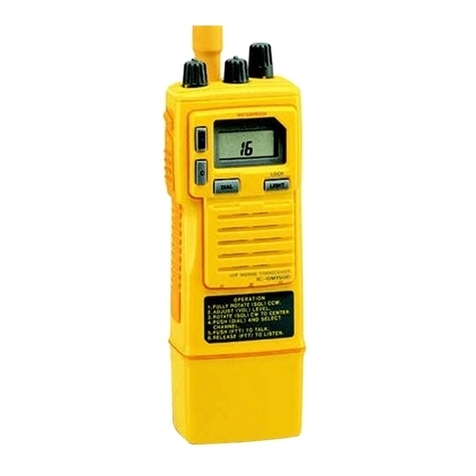
Icom
Icom IC-GM1500 User manual
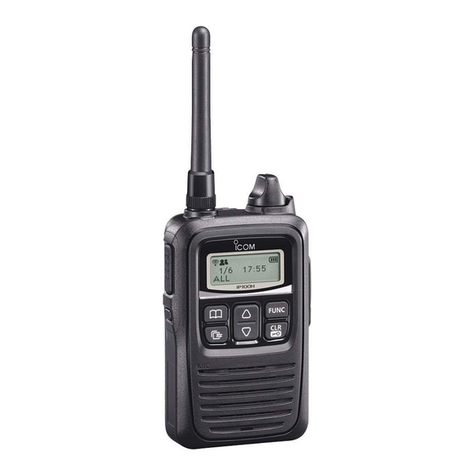
Icom
Icom IP100H User manual
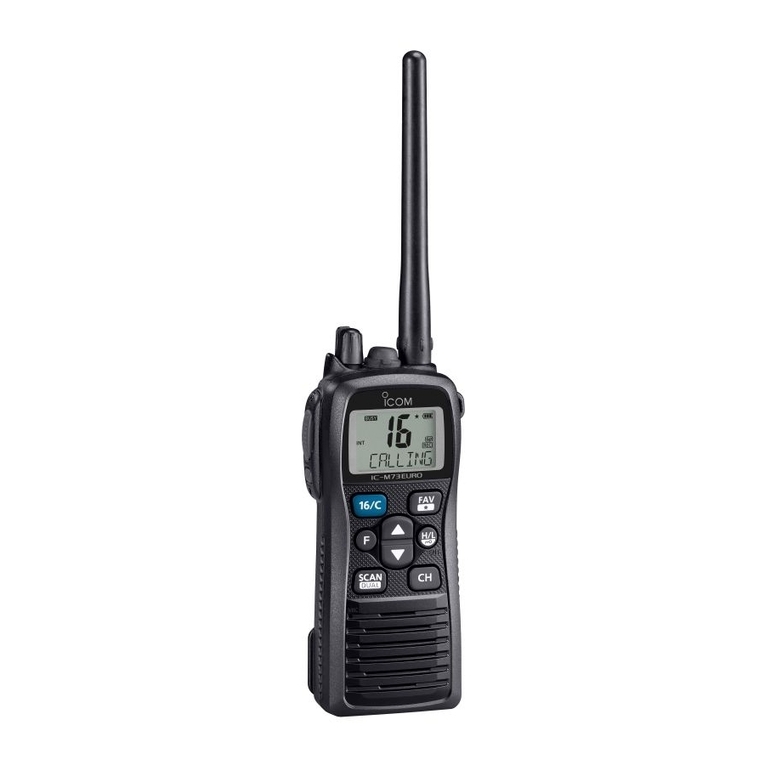
Icom
Icom IC-M73 User manual
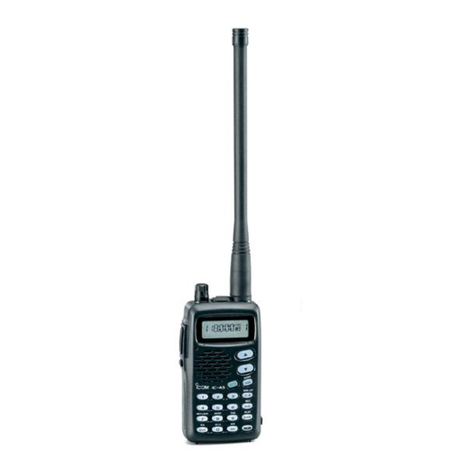
Icom
Icom IC-A23 Administrator Guide
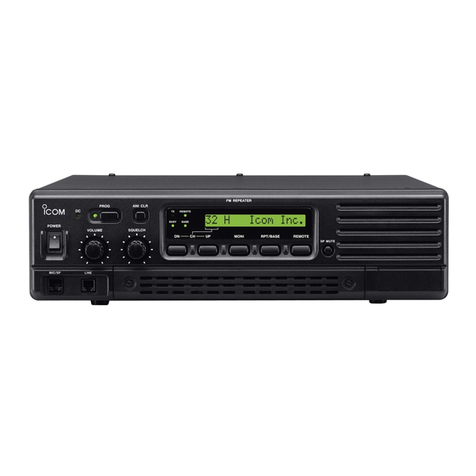
Icom
Icom IC-FR3000 Series User manual
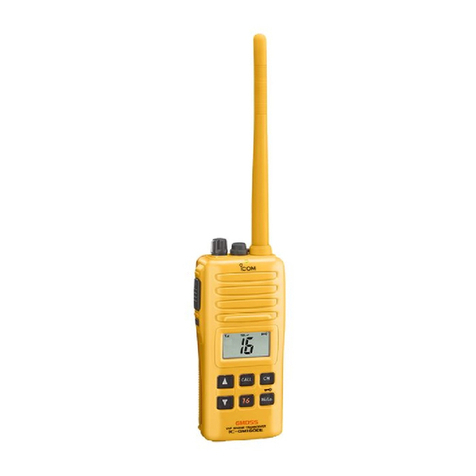
Icom
Icom IC-GM1600E User manual
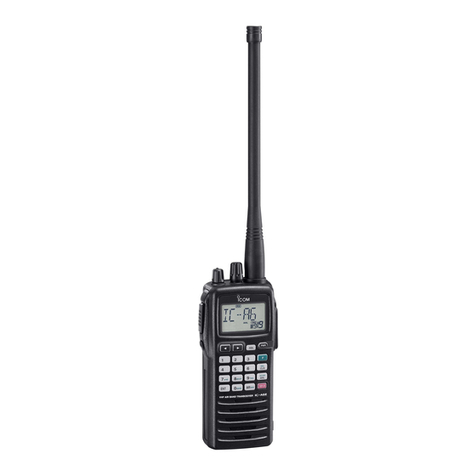
Icom
Icom IC-A24 User manual
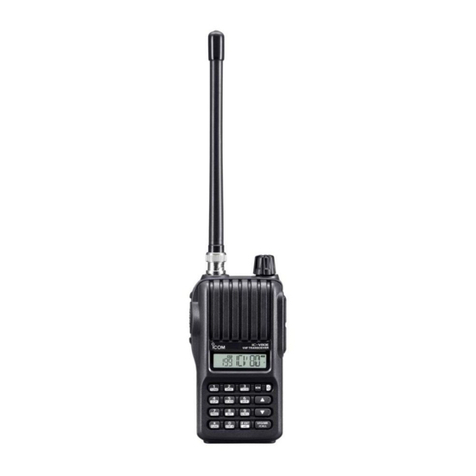
Icom
Icom IC-V80E Installation and operating instructions
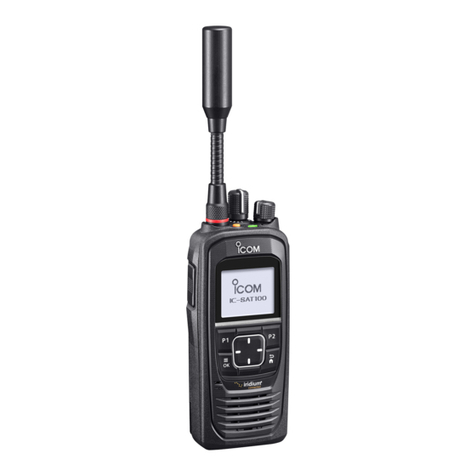
Icom
Icom IC-SAT100 Installation guide

Icom
Icom IP100H User manual
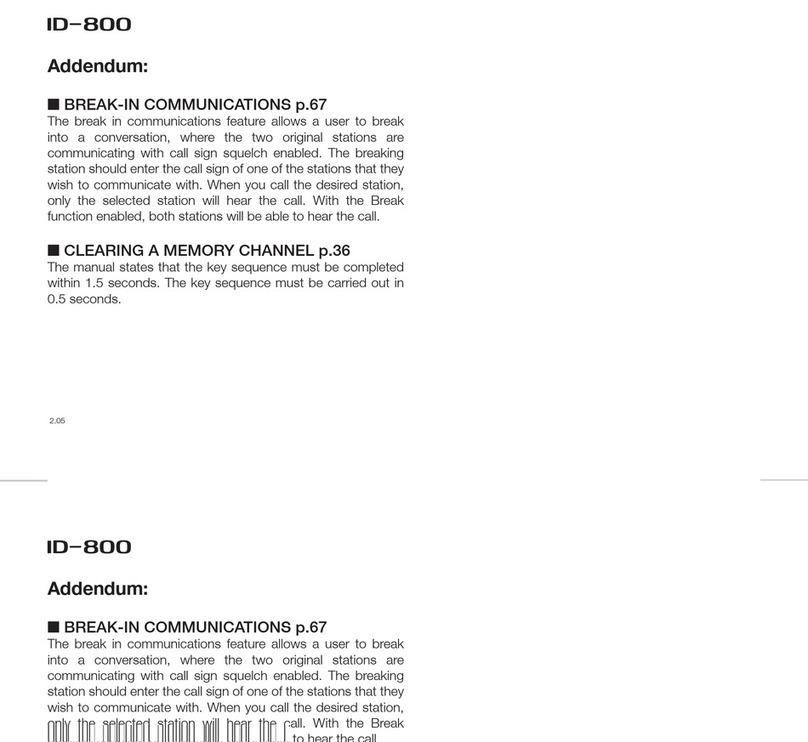
Icom
Icom ID-800H Installation and operating instructions
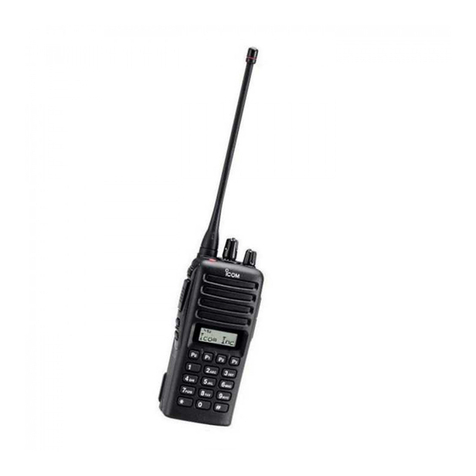
Icom
Icom IC-F43GT Operating instructions

Icom
Icom GM1600 21K User manual
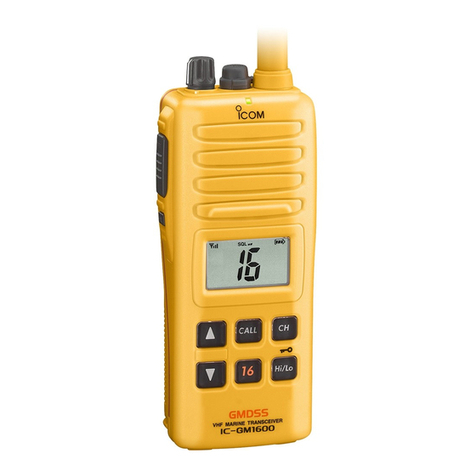
Icom
Icom IC-GM1600 User manual
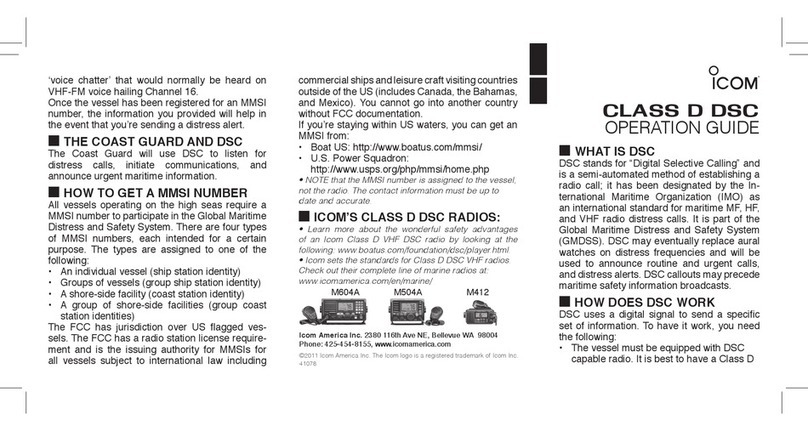
Icom
Icom M604A User manual

Icom
Icom IC-GM1600E User manual
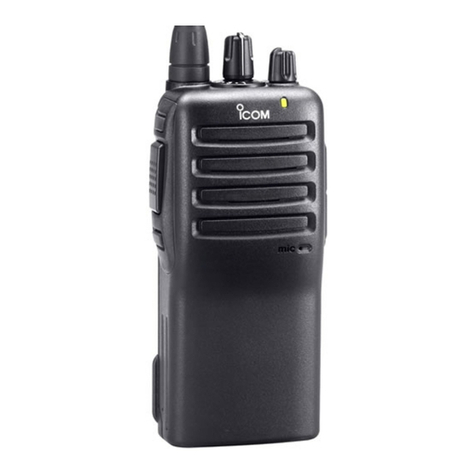
Icom
Icom CS-F14 User manual
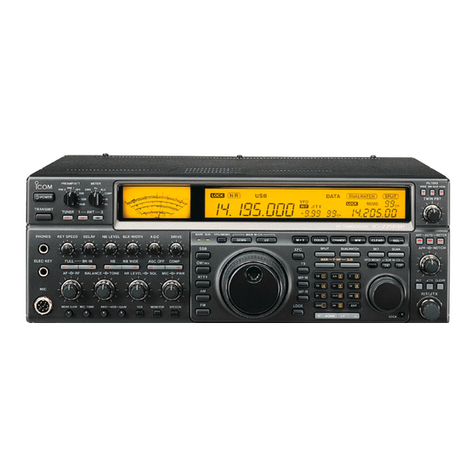
Icom
Icom IC-775DSP Operating manual

Icom
Icom IC-GM1500 User manual

Icom
Icom IC-703 Plus User manual
